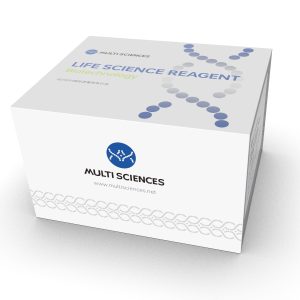HGNC ID: 10618
Target Abstract:
Chemokine ligand 2 (CCL2), also known as monocyte chemotactic protein 1 (MCP-1), is a small molecular weight cytokine of the CC chemokine family.CCL2 is anchored to the plasma membrane of endothelial cells via the mucopolysaccharide side chain of proteoglycans and is secreted mainly by monocytes, macrophages, and dendritic cells.CCL2 recruits monocytes, memory T cells, and dendritic cells to sites of inflammation caused by tissue injury or infection. CCL2 is involved in the pathogenesis of several diseases characterized by monocyte infiltration, such as psoriasis, rheumatoid arthritis, and atherosclerosis.CCL2 is involved in the neuroinflammatory process of several diseases occurring in the central nervous system, manifested as neuronal degeneration.
CCL2 Target Infomation Overview
- Target Symbol: CCL2, C-C motif chemokine ligand 2
- Gene Groups: Chemokine ligands
- Alias: MCP1; MCP-1; MCAF; SMC-CF; GDCF-2; HC11; MGC9434
- Previous Names: SCYA2
- Alias Names: monocyte chemotactic protein 1, homologous to mouse Sig-je; monocyte chemoattractant protein-1; monocyte chemotactic and activating factor; monocyte secretory protein JE; small inducible cytokine subfamily A (Cys-Cys), member 2; small inducible cytokine A2 (monocyte chemotactic protein 1, homologous to mouse Sig-je); chemokine (C-C motif) ligand 2
CCL2, C-C motif chemokine ligand 2 Target Infomation by Species
- Human
- Mouse
- Rat
Human CCL2 Target Information
- Target Symbol: CCL2, C-C motif chemokine ligand 2
- Alias:
- C-C motif chemokine 2
- chemokine (C-C motif) ligand 2
- GDCF-2
- HC11
- HSMCR30
- MCAF
- MCP-1
- MCP1
- MGC9434
- monocyte chemoattractant protein 1
- monocyte chemoattractant protein-1
- monocyte chemotactic and activating factor
- monocyte chemotactic protein 1
- monocyte secretory protein JE
- SCYA2
- small inducible cytokine A2 (monocyte chemotactic protein 1, homologous to mouse Sig-je)
- small inducible cytokine subfamily A (Cys-Cys), member 2
- small-inducible cytokine A2
- SMC-CF
- NCBI_Gene: 6347
- UniProtKB: P13500
Human CCL2 Predicted Functions
Predicted to enable CCR2 chemokine receptor binding activity and chemokine activity. Involved in several processes, including cellular response to cytokine stimulus; leukocyte chemotaxis; and regulation of apoptotic process. Located in extracellular region. Implicated in several diseases, including Henoch-Schoenlein purpura; aggressive periodontitis; autoimmune disease (multiple); gastrointestinal system cancer (multiple); and tuberculosis (multiple). Biomarker of several diseases, including autoimmune disease (multiple); liver disease (multiple); lung disease (multiple); non-alcoholic fatty liver disease (multiple); and retinal disease (multiple).
Mouse Ccl2 Target Information
- Target Symbol: Ccl2, chemokine (C-C motif) ligand 2
- Alias:
- AI323594
- expressed sequence AI323594
- HC11
- MCAF
- MCP-1
- MCP1
- monocyte chemoattractant protein-1
- monocyte chemotactic protein
- Scya2
- Sigje
- small inducible cytokine A2
- small inducible gene JE
- SMC-CF
- NCBI_Gene: 20296
Mouse Ccl2 Predicted Functions
Enables CCR2 chemokine receptor binding activity and cytokine activity. Involved in several processes, including cellular response to cytokine stimulus; positive regulation of leukocyte chemotaxis; and positive regulation of macromolecule metabolic process. Acts upstream of or within response to bacterium and response to wounding. Located in extracellular space. Is expressed in several structures, including heart; intestine smooth muscle circular layer; nervous system; retina; and vibrissa. Used to study age related macular degeneration. Human ortholog(s) of this gene implicated in several diseases, including Henoch-Schoenlein purpura; aggressive periodontitis; autoimmune disease (multiple); gastrointestinal system cancer (multiple); and tuberculosis (multiple). Orthologous to human CCL2 (C-C motif chemokine ligand 2).
Rat Ccl2 Target Information
- Target Symbol: Ccl2, C-C motif chemokine ligand 2
- Alias:
- C-C motif chemokine 2
- chemokine (C-C motif) ligand 2
- immediate-early serum-responsive JE protein
- immediate-early serum-responsive protein JE
- MCP-1
- monocyte chemoattractant protein 1
- monocyte chemoattractant protein-1
- monocyte chemotactic protein 1
- Scya2
- Sigje
- small inducible cytokine A2
- Small inducible gene JE
- small-inducible cytokine A2
- NCBI_Gene: 24770
- UniProtKB: P14844
Rat Ccl2 Predicted Functions
Enables chemokine activity and heparin binding activity. Involved in several processes, including cellular response to cytokine stimulus; cellular response to lipid; and leukocyte migration. Located in several cellular components, including perikaryon; perinuclear region of cytoplasm; and rough endoplasmic reticulum. Colocalizes with C-fiber. Used to study several diseases, including artery disease (multiple); diabetic angiopathy; interstitial lung disease (multiple); kidney disease (multiple); and pancreatitis (multiple). Biomarker of several diseases, including artery disease (multiple); cerebrovascular disease (multiple); lung disease (multiple); non-alcoholic fatty liver disease (multiple); and pancreatitis (multiple). Human ortholog(s) of this gene implicated in several diseases, including Henoch-Schoenlein purpura; aggressive periodontitis; autoimmune disease (multiple); gastrointestinal system cancer (multiple); and tuberculosis (multiple). Orthologous to human CCL2 (C-C motif chemokine ligand 2).

